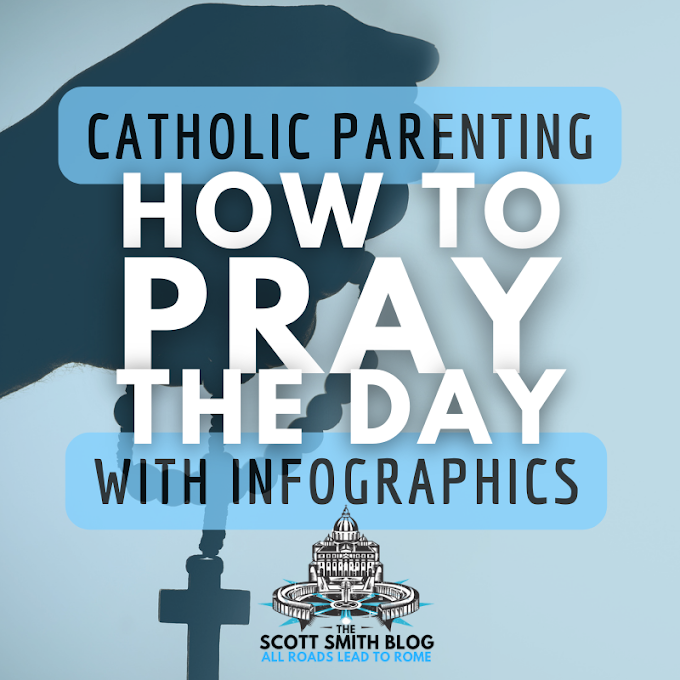People often wonder about Jesus' two genealogies. That is to say, people often wonder about St. Joseph's two genealogies. These two genealogies are found at Luke 3:23-38 versus Matthew 1:1-17
St. Joseph is described as having two different fathers and two different grandfathers. Having two different grandfathers is normal, but two fathers? How could that be?
I'll give you a hint. St. Joseph wasn't the only one with two fathers. Jesus did, too.
This will provide us some amazing spiritual insights into adoption and God's elevation of adoption.
Looking for genealogy charts for Jesus and St. Joseph? Just scroll down. I have also provided some good visual depictions of the genealogies of Jesus.
While we're on the subject of St. Joseph ...
I was so inspired by Father Calloway's Consecration to St. Joseph that I asked Fr. Calloway if we could write a Consecration to St. Joseph for Children and Families, as well.
And here it is:
Ite ad Joseph!
Please, especially you fathers, lead your families in prayer and consecrate them to St. Joseph! Enjoy :)
Also, are you in need of extremely powerful prayers for your work, family, job, employment, or to sell a house? Pray the Novena to St. Joseph!
So let's get to those genealogies!
You will enjoy this explanation ...
Why is Jesus' Genealogy Traced through Joseph?
First off, why is Jesus' genealogy traced through St. Joseph? This is a very important question.
The Answer: St. Joseph was the direct descendant of the kings of Israel. Specifically, St. Joseph was the great-great-great-(many greats)-grandson of King David. And St. Joseph's son would would one day be crowned, albeit in thorns, the King of the Jews.
The last line above says "IESUS NAZARENUS REX IUDAEORUM", which translates as "Jesus of Nazareth, King of Judaeorum (or Judah)".
St. Joseph, the Hidden King
The Gospels provide these genealogies to demonstrate that Jesus is the New King David. These genealogies prove that Jesus is part of the royal family and the line of kings.
If Jesus was part of the royal family, his father was royalty, too. St. Joseph was also a king. The Hidden King of Israel.
Why is St. Joseph called the "Hidden King"? This was King Herod's doing.
King Herod was the puppet King of Judea. The Roman Empire made him the King of the Jews, so they could control him. King Herod, however, was not part of the Jewish royal family. King Herod wasn't even a full-blooded Jew.
King Herod was an Idumaean. His family was from the Kingdom of Edom, south of Judah and Jerusalem. King Herod was basically a half-Jew. Edomites were the descendants of Esau. The Jews were all descended from Esau's brother, Jacob, who was renamed Israel. Jacob and Esau feuded, and so did their descendants.
 |
| Esau Selling His Birthright by Hendrick ter Brugghen, c. 1627 |
Because of this, King Herod's kingship was not legitimate. King Herod was ashamed of his illegitimacy. If King Herod couldn't make a legitimate claim to the throne of the Jews, he was going to make sure that no one could.
So, what did King Herod do?
King Herod burned the library of genealogies in the Temple of Jerusalem. Herod destroyed all the official written records tracing the line of kings.
For more on all this, check out the following:
Dr. Brant Pitre recently put out a great Bible study about St. Joseph. It's called The Hidden King: The Jewish Roots of St. Joseph. You can check it out here.
The Genealogy of Jesus Explained
Why Would St. Joseph Have Two Fathers and Two Grandfathers? Three Theories
Luke's genealogy (3:23-38) lists Joseph as the son of Eli (Heli), the son of Matthat. Matthew's genealogy (1:2-16) lists Joseph as the son of Jacob, the son of Matthan.
How do we reconcile this apparent contradiction? There is no definitive answer. The Catholic Church has not provided a ruling on this.
Theory #1 - Luke's Genealogy is Mary's, Not Joseph's - Genealogy of Mary, Mother of Jesus
One ancient theory and perhaps the most common is that Luke is providing Mary's genealogy, not Joseph's genealogy. This one is a bit of stretch, though, because Luke provides Joseph's name in the genealogy.
 |
| Is Luke's genealogy, a genealogy of Mary? |
Nevertheless, Luke's Gospel was heavily inspired by one of its chief sources: Mary, herself. Let's examine the other theories, as well ...
Theory #2 - Eusebius and Julius Africanus' Theory: Double Levirate Marriages[1]
Eusebius and Julius Africanus propose that both St. Joseph and his father were the sons of Levirate marriages.[1] One genealogy provides the biological father and the other provides the legal father.
So, what is a "Levirate" marriage? Levirate marriage is a type of marriage in which the brother of a deceased man is obliged to marry his brother's widow. Levirate marriage is described at Deuteronomy 25:5-6. Levirate marriage was practiced by many ancient societies besides just the ancient Jews. Levirate marriage is common in societies with a strong clan structure in which exogamous marriage, i.e. marriage outside the clan, is forbidden.
The weakness of this theory is that a double Levirate marriage would be very rare, though not impossible. Two Levirate marriages in a row would be really uncommon.
Theory #3 - St. Augustine's Theory: St. Joseph was Adopted
St. Augustine gave a whole sermon on "the agreement of the evangelists Matthew and Luke in the generations of the Lord." You can read the full sermon here.
St. Augustine proposes that St. Joseph was adopted. This is the simplest and most elegant theory.
St. Augustine's adoption theory also explains the subtle change in the texts of the two Gospels regarding, not just who "begat" whom, but the absence of a "begat". St. Augustine helps us understand which father was St. Joseph's biological father and which was his adopted father:
For Matthew, who is understood to make mention of that father of whom Joseph was born, enumerates the generations thus: This one begot the other, so as to come to what he says at the end, Jacob begot Joseph. But Luke — because he cannot properly be said to be begotten who is made a child either by adoption, or who is born in the succession of the deceased, of her who was his wife — did not say, Heli begot Joseph, or Joseph whom Heli begot, but Who was the son of Heli, whether by adoption, or as being born of the next of kin in the succession of one deceased.
It appears St. Joseph's biological father, like the Patriarch Joseph, was Jacob. According to St. Augustine, St. Joseph's adopted father was Eli (or "Heli").
The Elevation of Adoption
Think about how beautiful this is! St. Augustine's theory tells us a lot about the Holy Family and adoption.
Why was St. Joseph's heart so open to adopting Jesus? Because St. Joseph was an adopted son!
AND, Jesus had two fathers, an earthly and a heavenly father. Who better to be Jesus' earthly father, than a man who understood what it was like to have two fathers?
AND! This carries a spiritual message to all of us, as well. We are all the adopted children of God.
St. Augustine builds on this theme in his sermon. Augustine describes the mystery of how we become adopted into God's family through Jesus:
Yet the Apostle Paul does continually use this very word adoption, and that to express a great mystery. For though Scripture testifies that our Lord Jesus Christ is the only Son of God, it says, that the brethren and coheirs whom He has vouchsafed to have, are made so by a kind of adoption through Divine grace. When, says he, the fullness of time had come, God sent forth His Son, made of a woman, made under the law, to redeem them that were under the law, that we might receive the adoption of sons. And in another place: We groan within ourselves, waiting for the adoption, to wit, the redemption of our body. And again, when he was speaking of the Jews, I could wish that myself were accursed from Christ for my brethren, my kinsmen according to the flesh; who are Israelites, to whom pertains the adoption, and the glory, and the testaments, and the giving of the law; whose are the fathers, and of whom as concerning the flesh Christ came, Who is over all, God blessed forever. Where he shows, that the word adoption, or at least the thing which it signifies, was of ancient use among the Jews, just as was the Testament and the giving of the Law, which he mentions together with it.
AND, one last "and" ...
How blessed are they who become adoptive parents? Both Jesus and his earthly father, one of the greatest intercessors in all of Heaven, hold adoption very close to their hearts.
Genealogy of Jesus Luke vs. Matthew
If you're a visual person like me, charts are helpful. Here are some side-by-side charts comparing the Genealogy of Jesus found in the Gospel of Luke versus the Gospel of Matthew. That's Luke 3:23-38 versus Matthew 1:1-17.
Genealogy of Jesus Chart
Here is a nice, smaller chart comparing the Genealogies of Jesus found at Luke 3:23-38 versus Matthew 1:1-17. There's a bigger and longer one below, as well.
Genealogies of Jesus Side by Side:
Here is a chart provided by Tim Challies:
Footnotes on the Genealogies of St. Joseph in Matthew and Luke:
[1] Monnickendam, Yifat, "BIBLICAL LAW IN GRECO-ROMAN ATTIRE: THE CASE OF LEVIRATE MARRIAGE IN LATE ANTIQUE CHRISTIAN LEGAL TRADITIONS," Journal of Law and Religion, Cambridge University Press: January 2, 2020
Julius Africanus, in his letter to Aristides in the third century, addresses this contradiction, explaining it as a result of levirate marriage. Melchi and Mathan married the same woman, making their sons, Jacob and Heli, maternal brothers. When Heli died childless, his maternal brother, Jacob, married Heli's wife. Heli was therefore Joseph's father by law, rather than by nature:For whereas in Israel the names of their families were reckoned either according to nature or according to law (ἢ φύσει ἢ νόμῳ), according to nature (φύσει), indeed, by the succession of legitimate offspring (γνησίου), and according to law (νόμῳ) whenever another raised up children to the name of a brother dying childless …Thus, though of two different families, we will find Jacob and Heli maternal brothers. And of these, the one Jacob, having taken the wife of his brother Heli, who died childless, begat by her the third, Joseph, his son by nature and by reason (κατὰ φύσιν … κατὰ λόγον). Hence, it is written, “And Jacob begat Joseph,” but according to law (κατὰ νόμον) he was the son of Heli, for Jacob his brother raised up seed to him.Footnote41The levirate marriage described here follows the aforementioned biblical description of sperm donation or ghost marriage: when a man died childless, the child born to the levir and his former sister-in-law succeeded his deceased uncle—his mother's first husband—as though he were his legitimate son. Julius Africanus, however, adds to this description and distinguishes between “a son by nature” and “a son by law”—the former being the son of the biological father (the levir) and legitimate heir, and the latter being the son of the deceased uncle. This explanation suits Roman legal thinking in two respects. First, as noted earlier, Roman law developed the idea that only legitimate children (γνήσιος, legitimus) born of legitimate marriages (conubium) could inherit. Second, Roman law cultivated the notion of non-biological family relations, especially adoption. Indeed, Roman jurists acknowledged and developed cases of a father by law rather than by nature. In fact, this also correlates with the claim that the insertion of the genealogies into the Gospels was, from the outset, based on the concept of adoption. According to the Gospels, Joseph is not Jesus's father, because Jesus is the son of God. Joseph was married to Mary, Jesus's mother, and raised Jesus, but did not beget him. Thus, Jesus's Davidic lineage is only significant if we assume that the relationship between Jesus and Joseph was strong enough to bequeath legal status and family ties.Eastern and western Christian authors accepted and repeated Julius Africanus's explanation of Joseph's genealogy, his description of levirate marriage and his distinction between natural and legal paternity. At the beginning of the fourth century, Eusebius (ca. 263 CE–ca. 339 CE) cites Africanus's epistle in his Ecclesiastical History, repeating this claim in his Questions. Severus of Antioch (d. 538 CE), whose writings were preserved in Syriac, yet written in Greek and deeply influenced by Roman law, accepts the distinction between natural and legal paternity in a homily dedicated to the contradiction between Matthew and Luke. This claim was particularly popular in Latin Christian literature and can be found in Jerome's Commentary on Matthew of 398 CE, Ambrose of Milan's Exposition on Luke, Hilary of Poitiers’ Commentary on Matthew, and Ambrosiaster's Questions on the Old and New Testament. In the fifth century, when reiterating this claim, Augustine explicitly used the term adoption to explain the relationship between the deceased brother and his newborn biological nephew.



















7 Comments
http://www.drbo.org/chapter/49003.htm
A minority view holds that while Luke gives the genealogy of Joseph, Matthew gives the genealogy of Mary. A few ancient authorities seem to offer this interpretation. Although the Greek text as it stands is plainly against it, it has been proposed that in the original text Matthew had one Joseph as Mary's father and another as her husband. This neatly explains not only why Matthew's genealogy differs from Luke's, but also why Matthew counts fourteen generations rather than thirteen. Blair sees the various extant versions as the predictable result of copyists repeatedly attempting to correct an apparent mistake. Others, including Victor Paul Wierwille, argue that here the Aramaic original of Matthew used the word gowra (which could mean father), which, in the absence of vowel markings, was read by the Greek translator as gura (husband). In any case, an early understanding that Matthew traced Mary's genealogy would explain why the contradiction between Matthew and Luke apparently escaped notice until the 3rd century.